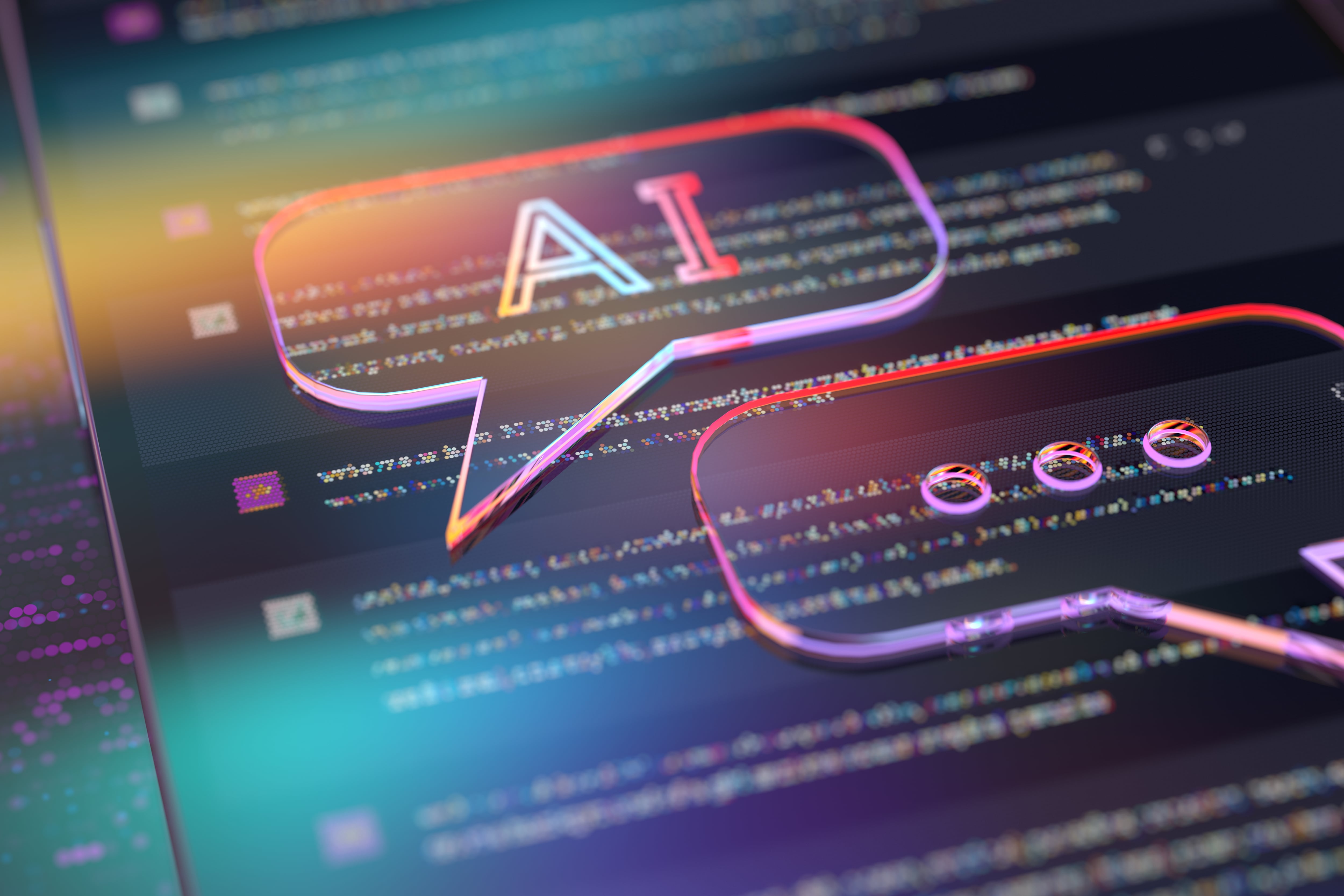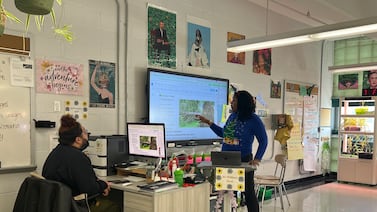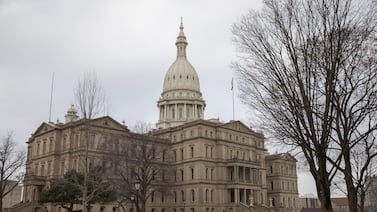Sign up for Chalkbeat New York’s free daily newsletter to keep up with NYC’s public schools.
A year ago, James Randle, a high school social studies teacher in Queens, started exploring how artificial intelligence could help make his work more efficient.
He experimented with one AI-powered program that surprised him with its ability to render basic lesson plans. Then Randle discovered an essay grader that used artificial intelligence to determine how well student papers adhered to a rubric — a tool he found useful for conducting first passes on essays.
“I was blown away by what it could possibly do,” said Randle, who has taught at the Academy of American Studies for 24 years.
Randle isn’t alone in seeing potential for AI-powered tools to make waves in the education sector. In recent years, a rash of new AI technologies have cropped up, with a spate of companies marketing their tools toward school districts. And across the country, nearly 20% of K-12 teachers reported using AI in their instruction last school year, according to one report.
The explosion of school-oriented AI technology has sparked serious concerns among skeptics — with critics raising questions over how AI companies handle sensitive student data and whether such tools can be trusted in education settings after cases of bias and inaccuracy.
In New York City, the public school system has taken nascent steps toward embracing the new technology. Despite some early reservations, former schools Chancellor David Banks became an AI cheerleader by the end of his tenure at the helm of the nation’s largest school system, touting its ability to “revolutionize” schools in a speech last month and devoting his final day as chancellor to a convening of an AI advisory council.
Despite enthusiasm from some of the city’s top education leaders, teachers are still waiting for the Education Department to issue more concrete guidance or plans for how and when AI should be used in schools. And in the meantime, educators are taking matters into their own hands, with Randle and others wading through the barrage of new companies promising to streamline time-consuming aspects of their jobs.
Randle said he “fell into a rabbit hole” of different AI-powered tools last year — struck by just how many were geared toward educators.
“Every time I kept turning around, there were more and more opportunities for teachers,” he said. “It was like a train rush.”
In AI, some educators see potential. Others see danger.
Two years ago, generative AI exploded into the public eye with the release of ChatGPT, a chatbot developed by the tech company OpenAI that stunned users with its ability to generate cogent and lifelike writing.
ChatGPT sparked a wave of concerns in schools across the nation — earning a ban on school devices and networks in New York City — amid broad fears that students would use the tool to cheat on assignments.
But the city has since reversed that ban, and some educators have warmed to the notion that generative AI could be a valuable tool for students and teachers alike.
Jenna Lyle, a spokesperson for the city’s Education Department, said the DOE was “currently developing guidelines for educators that are in alignment with the city’s Office of Technology Innovation.”
“Generative AI is constantly evolving,” she said in a statement. “As we prepare our students to be on the cutting edge of this technology, we are encouraging safe and responsible experimentation in the classroom and continuing to gather feedback and insights from industry leaders through our AI Advisory Council.”
Edward Castro, the family leadership coordinator for the city’s Consortium, International, and Outward Bound schools, said his district has partnered with the PlayLab, a tech company that develops AI-powered tools for educators. He’s found their tools particularly helpful when it comes to translating materials for families whose first language isn’t English.
“We wanted to make sure that we explained to educators that this is not a toy or a cheating vessel,” he said. “It’s a tool to help streamline and automate routine tasks, and to support our kids, especially our kids for whom English is not their first language.”
Generative AI chatbots, like ChatGPT, operate by analyzing large swaths of data, then predicting what text would likely follow a user’s prompt. But critics are quick to note that those responses don’t necessarily adhere to logical reasoning and aren’t guaranteed to be accurate, with reported instances where the tools have produced incorrect and biased responses.
Because of these deficiencies, Benjamin Riley, the founder of Cognitive Resonance, an organization that provides consulting on generative AI systems, is concerned that some school districts have looked to generative AI as a way of providing students with personalized tutors, or for teachers to speed up the grading process.
“It takes me all of two minutes with any of the existing tools that are out there to demonstrate just how unreliable they are with what we humans would consider the truth,” Riley said.
His organization has raised alarm over the ways in which generative AI technologies fall short in classroom settings — noting that such tools may not correctly understand what sequence of lessons will effectively build knowledge in students, might propose content based on misconceptions about how students learn, and could potentially spread misinformation or perpetuate cultural biases.
Riley added he understands why educators might look to AI-powered tools to ease the burden of grading, but he noted such tools tend to focus primarily on grammar and structure.
“Since they’re not thinking devices, there’s no capability for them to imagine what was going on in the mind of the student,” he said. “What I’m really worried about is that it won’t be wrong, but it will just be steering students toward a norm that what really matters is getting the surface features of your essay right, rather than grappling with the ideas.”
Randle, who has been using the AI-powered CoGrader to help markup student papers based on a grading rubric, said at times the tool will grade students more harshly than he would. He always checks to ensure that papers are graded correctly and to adjust the AI’s scoring.
But the tool has saved him hours on grading and allowed him to spend more time giving personalized comments, he said. So far, Randle has been paying for access to CoGrader and other AI tools he’s using as an individual, with no schoolwide contract.
Cora Neville, the principal of Highbridge Middle School in the DREAM charter network, said schools in her charter network have also been using AI-powered tools to help with grading and lesson planning. Before, grading student constructive responses could take four or more hours.
Using AI-powered tools from PlayLab sped that process up to about an hour, Neville said.
Can AI companies be trusted with student data?
With the arrival of AI, some educators remain wary over whether tech companies can appropriately handle sensitive student data.
For example, in a set of “guardrails” released over the summer, the American Federation of Teachers emphasized that safety and privacy should be maximized any time such tools are used in school settings.
Those concerns boiled over in California earlier this year, after the Los Angeles Unified School District attempted to roll out its own custom-built chatbot. But the tool, which relied on a large pool of student data, was later paused after the company that produced it collapsed amid concerns that the chatbot mishandled sensitive student data.
Castro said that he’s taken concerns over how AI companies handle student data seriously.
“Making sure that things are fair, unbiased, and that privacy is protected is paramount,” he said of his district’s approach to using AI. “Anything I put in is public-facing.”
Neville said she’s seen AI-powered tools marketed toward certain aspects of the school system that involve confidential student data — like those that offer to generate individualized education programs, which outline mandated services and support for students with disabilities.
“That information, for one, is confidential. But you also want to know your students intimately and deeply,” she said. “I would hate for someone to say, ‘Alright, I’m going to use these prompts, I’m going to throw this information into it, and it’s going to write the IEP for me.’”
“I don’t want to lose sight of the intimacy of really getting to know your students,” Neville added.
Despite drawbacks, some hope AI can reduce teacher burnout
Though imperfect, Randle hopes that AI tools can help stem some of the losses of early career teachers, who have left the field in increasing numbers since the onset of the COVID pandemic in 2020. It’s a use he believes could be particularly meaningful, as teacher turnover hit unusual highs both nationally and in New York City during the pandemic.
“With any resource that teachers are using, someone may have things they don’t approve of,” Randle said. “But every teacher is going to look over everything that they are going to put in front of kids, and everything they’re going to ask kids to engage with.”
In addition to saving hours on grading, he sees generative AI as a useful tool for new teachers who are still learning to construct lesson plans.
Randle was initially stunned by the ability of Khanmigo, an AI-powered teaching assistant, to generate templates for different lesson plans. Though it didn’t create worksheets and other materials that a teacher might need, he noted it offered the building blocks of a comprehensive lesson.
More recently, he has been using MagicSchool, another AI-powered tool, that Randle said can create even more comprehensive lesson plans — replete with presentation slides, quizzes, worksheets, and even songs or jokes that educators can sprinkle into lessons.
“It’s a great place to get some good ideas and brainstorm,” he said, adding that for new teachers in particular, “it’s hugely helpful to have a system in place and not have to start from scratch.”
Neville, too, sees potential for AI to help younger teachers. But she added it isn’t all upside — as the streamlined process could make it more difficult to learn.
“It takes that learning experience away from the teacher,” she said. “When I came up, there was no AI generator. So not only did you have to be a skilled teacher, you also had to know the content well.
“You really have to be tactful with how much you rely on the system,” Neville said.
Julian Shen-Berro is a reporter covering New York City. Contact him at jshen-berro@chalkbeat.org.






